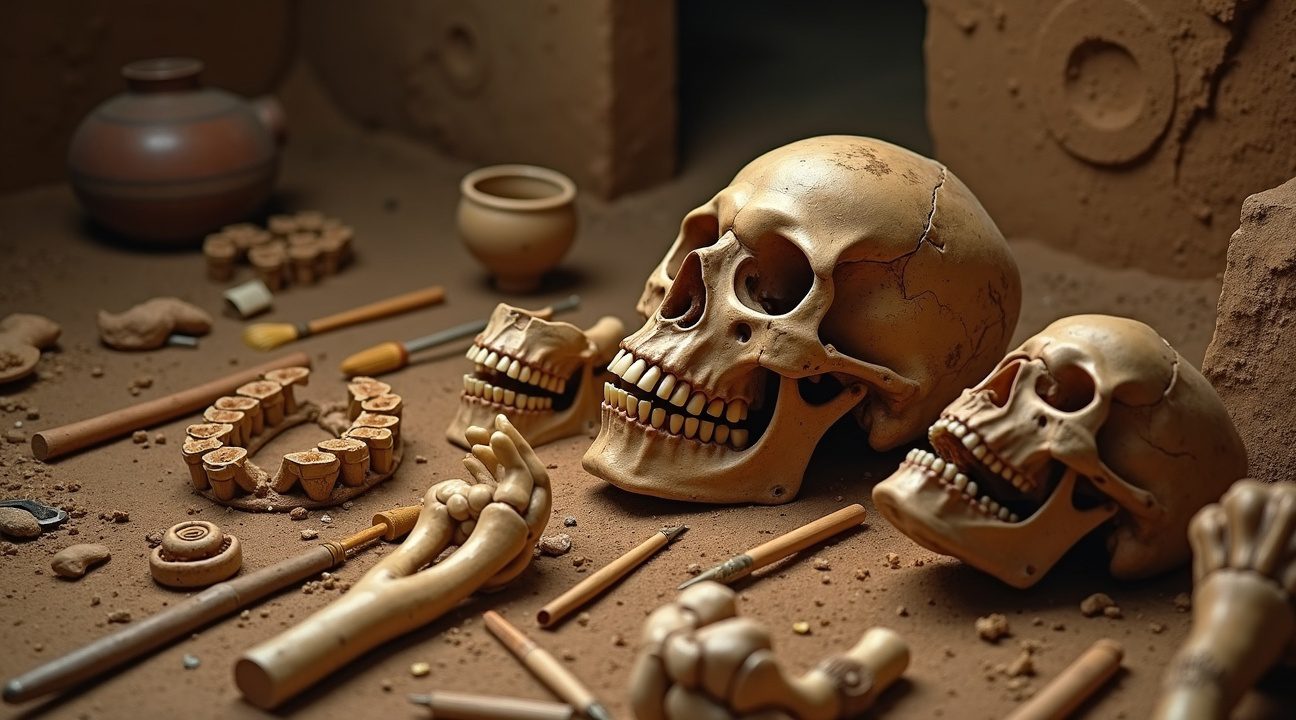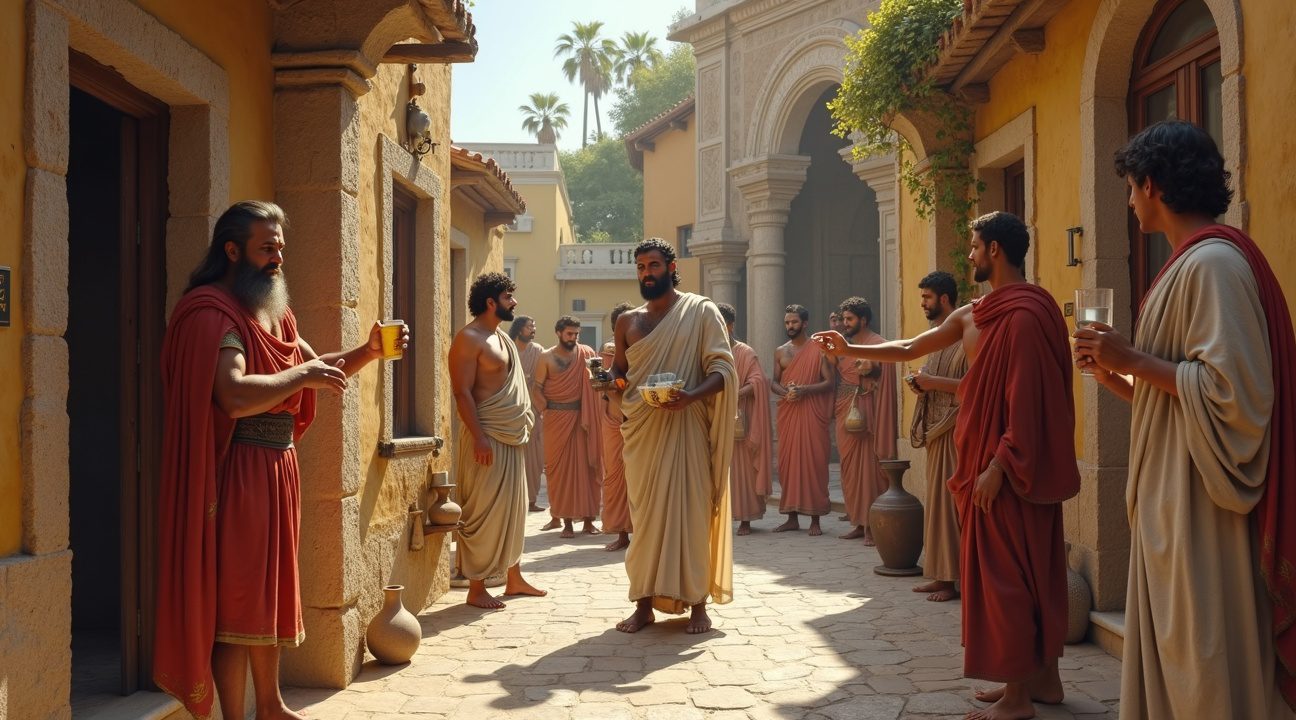Ancient Romans embraced an extraordinary dental hygiene routine that shocks the modern world: the use of human and animal urine as mouthwash and toothpaste. They believed this unconventional method could whiten teeth and prevent decay. The demand for this practice increased to such an extent that Emperor Vespasian implemented a formal tax—known as the vectigal urinae—on the collection and distribution of urine. Portuguese urine became especially prized for its alleged superior quality.
Key Takeaways
- Romans used urine for dental care due to its ammonia content, which provided natural cleansing and whitening properties with some antibacterial benefits.
- Portuguese urine was highly esteemed and imported into Rome, prompting Emperor Vespasian to regulate and tax its collection as a valuable commodity that supported the empire’s economy.
- Archaeological finds in Pompeii suggest many Romans had healthy teeth, with only about one-third showing evidence of missing teeth—significantly fewer than in later medieval populations.
- Not all Romans endorsed urine-based dental care; wealthy citizens and educated elites often derided it as uncivilized and preferred imported dental products, associating urine mouthwash with the lower social classes.
- Roman toothpaste ingredients were bizarre by modern standards, including crushed bones, oyster shells, pumice stone, charcoal, animal hooves, and even mouse brains, all applied using frayed wooden sticks.
For more insight into daily life and hygiene in Ancient Rome, including practices like these, visit the Encyclopædia Britannica’s page on Ancient Rome.
Romans Imported Portuguese Urine and Taxed It for Teeth Whitening
Ancient Romans possessed an unusual approach to dental hygiene that modern people would find shocking. They believed human and animal urine served as an effective mouthwash and toothpaste additive, capable of whitening teeth and preventing decay. This practice wasn’t limited to local sources — Romans actively imported urine in substantial quantities, with Portuguese urine being particularly prized for its supposed superior quality.
The demand for urine as a dental care product became so significant that it caught the attention of the imperial treasury. Emperor Vespasian recognized the commercial potential of this trade and introduced the vectigal urinae, a formal tax on urine collection and distribution. This urine tax transformed what might have been a simple waste product into a regulated commodity that contributed to Rome’s economic system.
The Science Behind Roman Urine Dental Care
Romans weren’t entirely wrong about urine’s cleaning properties, though their understanding of the science was limited. Fresh urine contains ammonia, a compound that acts as a natural cleansing and whitening agent. This ammonia provided antibacterial action similar to modern mouthwashes, though obviously with different ingredients and concentrations. The chemical properties of ammonia can break down stains and kill certain bacteria in the mouth, which explains why Romans noticed improved dental hygiene after using urine-based treatments.
Portuguese urine gained particular favor among wealthy Romans who could afford imported dental products. The preference for Portuguese urine likely stemmed from dietary differences between regions, as diet directly affects urine composition. Romans believed that people from different geographic areas produced urine with varying qualities for dental care purposes.
The vectigal urinae demonstrates how seriously Romans took this practice. Emperor Vespasian’s decision to tax urine collection created an entire industry around what we now consider waste. Collectors would gather urine from public latrines and private sources, process it for dental use, and distribute it throughout the empire. The tax revenue from this unusual commodity helped fund various imperial projects and administrative costs.
This dental practice persisted well beyond the fall of Rome. Historical records show that urine continued as a dental rinse in various European regions until the 1700s, demonstrating the lasting influence of Roman medical and hygiene practices. Rural communities particularly maintained these traditions, often lacking access to alternative dental care methods that were becoming available in urban centers.
The Roman approach to dental hygiene reveals their pragmatic attitude about bodily functions and waste products. They viewed urine not as something disgusting but as a useful resource with practical applications. This mindset allowed them to develop what they believed were effective dental care solutions using readily available materials.
Modern dental science has moved far beyond these ancient practices, but the Roman use of urine for teeth whitening represents an early example of humans attempting to understand and manipulate chemical processes for health benefits. While we now have safer and more effective alternatives, the ammonia-based cleaning principle that Romans accidentally discovered remains relevant in various cleaning applications today.

Archaeological Evidence Shows Romans Had Remarkably Healthy Teeth
Archaeological excavations at Pompeii and Herculaneum reveal a surprising truth about Roman dental health that challenges modern assumptions about ancient hygiene practices. The preserved remains from these volcanic sites show that Romans maintained remarkably healthy teeth compared to many later civilizations, suggesting their unconventional oral care methods may have been more effective than previously believed.
Skeletal analysis indicates that only about one-third of Roman individuals had missing teeth, a significantly lower rate than what archaeologists typically find in medieval populations. Even more striking, dental enamel examination reveals relatively few cavities among these ancient populations. This evidence suggests that Roman dental practices, including their use of urine-based mouthwashes, contributed to better oral health outcomes than many societies achieved for centuries afterward.
Roman Dental Innovations and Treatments
The archaeological record demonstrates that Romans developed sophisticated dental treatments that went far beyond basic hygiene. Evidence shows they performed tooth extractions using specialized tools, created functional dentures from bone or ivory, and constructed dental bridges to replace missing teeth.
These prosthetics often featured materials like ivory, bone, or even gold for wealthy citizens, indicating a well-developed understanding of dental restoration.
Romans also crafted crowns to protect damaged teeth, using techniques that wouldn’t be seen again in Europe for many centuries. The quality of these dental interventions, combined with the overall health of Roman teeth found at archaeological sites, suggests their oral care regimen was surprisingly effective.
The low rates of caries found in Roman dental remains likely resulted from multiple factors beyond their urine-based oral care. Their diet contained significantly less refined sugar than modern diets, which naturally reduced tooth decay. However, the combination of dietary factors with their hygiene practices, including regular use of ammonia-rich urine as a whitening and cleaning agent, appears to have created an environment where dental health thrived.
Archaeological evidence from Pompeii dental remains particularly highlights how Romans maintained their teeth throughout their lives. Unlike many ancient populations where tooth loss was common by middle age, Romans often retained functional teeth well into their later years. This dental longevity suggests their oral care methods, however unusual by today’s standards, provided genuine protective benefits that modern archaeology continues to validate through careful examination of preserved remains.

The Bizarre Ingredients Romans Ground Into Toothpaste
Roman dental care involved ingredients that would shock modern users. I find it fascinating how Romans combined practical materials with truly unusual components to create their cleaning preparations. Beyond urine, which served as their primary whitening agent, Roman toothpaste contained a startling array of ground substances.
Common Abrasive Materials in Roman Dental Products
Romans created their dental powders by grinding various materials into fine, abrasive textures. The most frequently used ingredients included:
- Crushed bones from various animals, providing calcium and abrasive qualities
- Oyster shells and eggshells, which offered similar calcium-rich scrubbing power
- Pumice stone, delivering intense abrasive action for stubborn stains
- Charcoal and wood ashes, believed to absorb odors and whiten teeth
- Animal hooves, ground to create coarse cleaning particles
- Mouse brains, considered a delicacy ingredient for dental health
- Various herbs for flavoring and supposed medicinal benefits
These ingredients were meticulously pulverized using grinding stones until they reached a powder consistency suitable for dental application. Honey frequently served as a binder, mixing with the powdered components to create a paste-like substance. Water occasionally replaced honey when a less sticky consistency was preferred.
Romans applied these abrasive powders using primitive tools that preceded modern toothbrushes. Frayed sticks, often made from aromatic woods, served as the primary application method. Users would dip these wooden implements into their prepared dental mixture and scrub their teeth vigorously. Some Romans preferred using small twigs with naturally fibrous ends, while others fashioned early toothbrush-like tools by attaching animal hair to wooden handles.
The preparation process required considerable effort, as each ingredient needed proper grinding to achieve the right texture. Coarse particles could damage tooth enamel, while overly fine powders lacked sufficient cleaning power. Romans understood that achieving the correct balance meant the difference between effective cleaning and potential dental harm.
These cleaning methods reflected Roman beliefs about dental hygiene, where stronger abrasives were considered more effective. The inclusion of unusual ingredients like mouse brains demonstrates how Romans blended superstition with practical cleaning approaches. Their dental care routines, though bizarre by contemporary standards, represented serious attempts to maintain oral health using available materials and prevailing medical knowledge.

Not All Romans Embraced Urine Mouthwash – Some Mocked It
Roman society wasn’t uniformly enthusiastic about using urine for dental hygiene. Many educated Romans viewed this practice with disdain, particularly when they associated it with foreign customs or lower social classes.
The poet Catullus famously ridiculed the practice in his satirical works, often linking it to Celtiberian customs from the Iberian Peninsula. His writings suggest that Romans considered urine mouthwash a barbaric foreign habit rather than a sophisticated dental care method. These literary references indicate that the practice carried social stigma among Rome’s elite circles.
Social Class and Regional Distinctions
Evidence suggests urine-based oral care wasn’t evenly distributed across Roman society. The practice appears more commonly documented among:
- Lower socioeconomic classes who couldn’t afford imported dental care products
- Certain regional populations, particularly those with Celtic influences
- Rural communities with limited access to alternative hygiene methods
- Areas where Greek medical traditions hadn’t fully penetrated
Wealthy Romans typically had access to imported tooth powders, aromatic mouth rinses, and professional dental care. They could afford alternatives like crushed pearls, powdered horn, or exotic spices for oral hygiene. This economic divide created cultural associations between urine mouthwash and poverty or lack of refinement.
Roman satirical literature frequently mocked individuals who practiced urine-based dental care, treating it as a marker of social inferiority. Writers used these references to insult political enemies or social rivals, suggesting the practice was considered embarrassing enough to serve as effective mockery. The fact that Romans used this habit as ammunition for social ridicule demonstrates how contentious the practice actually was.
Archaeological evidence supports this class-based division. Excavations of wealthy Roman households reveal sophisticated dental care implements and imported hygiene products, while simpler dwellings show fewer specialized oral care tools. This material evidence aligns with literary sources suggesting that urine mouthwash was primarily a practice of necessity rather than preference.
Regional variations also played a significant role in acceptance levels. Roman colonies with strong indigenous influences maintained local hygiene traditions longer than areas with heavy Roman cultural penetration. Urban centers like Rome itself showed more resistance to the practice compared to frontier regions where Roman customs mixed more freely with local traditions.

How Roman Dental Care Compares to Modern Standards
Roman dental practices couldn’t be more different from today’s fluoride-based oral care routines. While Romans genuinely believed urine provided antibacterial benefits for maintaining white teeth, modern dentistry relies on scientifically-proven fluoride compounds, ergonomic toothbrushes, and professionally regulated treatments that would seem like magic to ancient Romans.
The Evolution from Ancient to Modern Methods
The transformation from Roman urine rinses to contemporary dental care represents centuries of scientific advancement. Toothbrushes didn’t appear until the 18th century, replacing the Romans’ reliance on finger rubbing and cloth cleaning. Fluoride entered dental care during the 20th century, revolutionizing cavity prevention in ways Roman physicians couldn’t have imagined. Today’s dental technology includes electric toothbrushes, water flossers, and antimicrobial mouthwashes that target specific bacteria without the unpleasant side effects of ancient remedies.
Modern standards emphasize prevention through regulated fluoride levels, professional cleanings every six months, and evidence-based treatments. Romans focused on immediate cleansing effects, often using harsh substances that damaged enamel over time. Contemporary dentistry balances effectiveness with long-term oral health preservation.
Ancient Alternatives Across Cultures
Romans weren’t alone in their unconventional dental approaches. Ancient Egyptians created tooth powders from pumice stone and wine vinegar, believing the abrasive mixture would scrub away decay. Greek civilizations developed their own abrasive powders using crushed bones, oyster shells, and charcoal. These methods shared the Roman philosophy of aggressive cleaning, though each culture added unique ingredients based on local availability.
Egyptian practices actually showed more sophistication than Roman techniques in some areas. They understood the importance of breath freshening and created early versions of breath mints using herbs and spices. Greeks contributed to dental knowledge by recognizing the connection between diet and tooth health, though they still relied on damaging abrasives.
Chinese ancient medicine took a different approach entirely, focusing on internal balance and herbal treatments rather than external scrubbing. Their methods emphasized preventing dental problems through overall health rather than treating symptoms after they appeared.
Modern dental care has borrowed concepts from various ancient cultures while eliminating harmful practices. The emphasis on prevention that Chinese medicine promoted now forms the foundation of contemporary dental philosophy. However, unlike ancient Romans who turned to readily available bodily fluids, today’s practitioners rely on laboratory-tested compounds that provide measurable benefits without health risks.
Sources:
Ancient Origins: “Romans Used Powdered Mouse Brain and Human Urine in Their Toothpaste”
Wilmington Oral Surgery Blog: “Did the Ancient Romans Have Better Teeth than We Do Today?”
American Dental: “A Look Back at Dentistry in Ancient Rome”
Tastes of History: “Dispelling Some Myths: Romans Cleaned Their Teeth with Urine”
Decisions in Dentistry: “A Glimpse Into the Oral Hygiene Regimens of Ancient Romans”
DOCS Education Blog: “The Ancient Romans Had Healthier Smiles Than We Do Today”
The Avenue Dental Group: “The History of Teeth Cleaning: From Ancient Times to Today”
Sindecuse Museum of Dentistry: “Timeline of Dental Hygiene”


